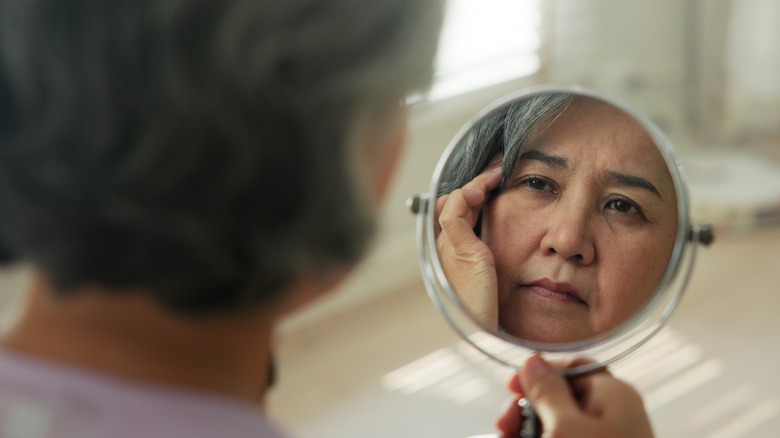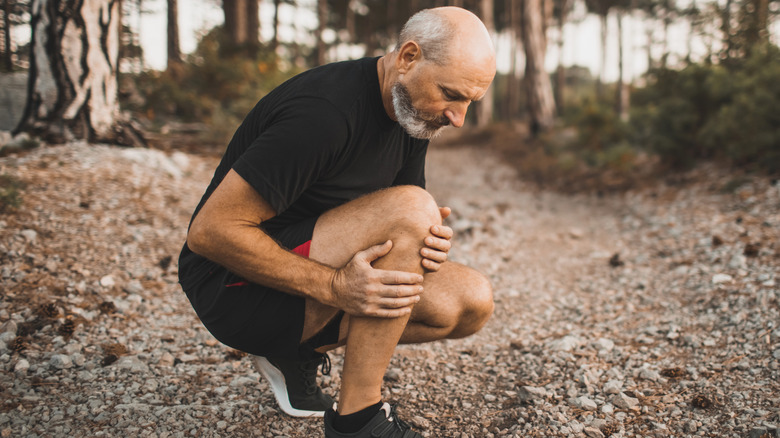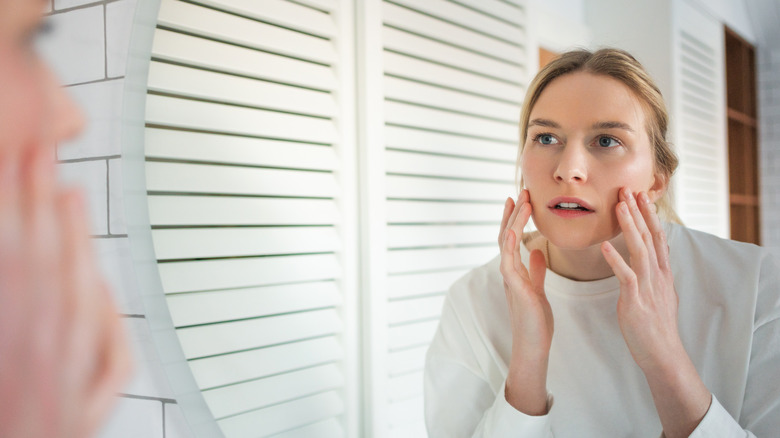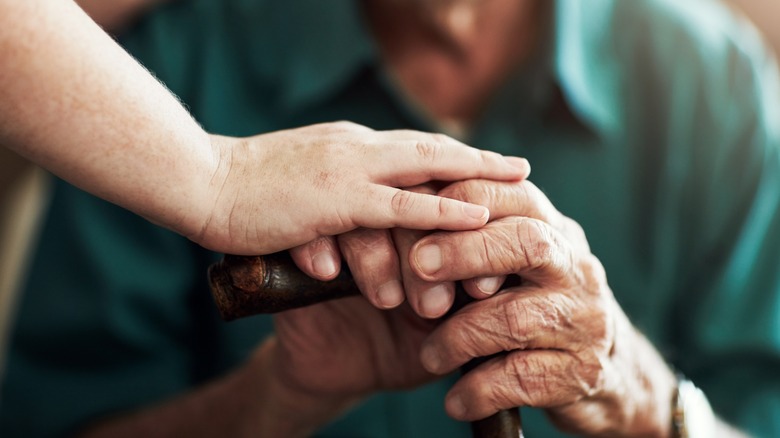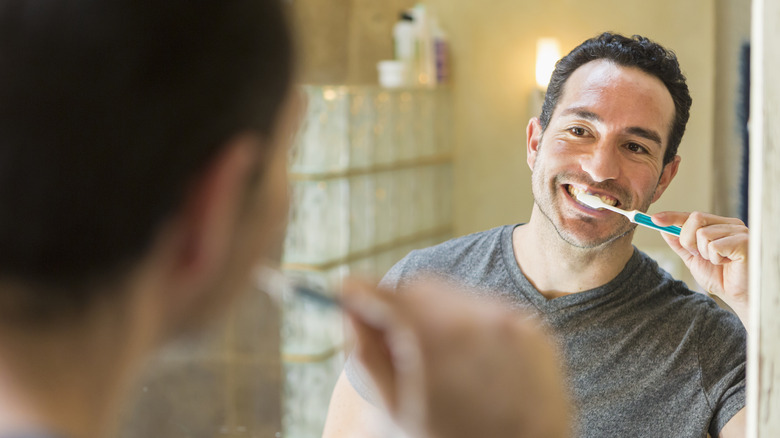9 Body Parts That Are Aging Faster Than You Are
You might be feeling young, but your body could be telling a different story. From creaky joints to receding gums, certain parts of your body may be growing older than the rest of you.
According to a 2023 study published in Nature, nearly 20% of the people profiled had at least one organ that was older than they were biologically. These people ran the risk of heart disease, Alzheimer's, diabetes, and mobility problems due to skeletal muscle issues. WebMD reports that there are some telltale signs to look out for as you age that could be an indicator that your body's aging is superseding your own. These include slower walking, memory issues, sun spots on your skin, and aches and pains in your joints.
Below are some body parts that, depending on how well you maintain them and certain lifestyle and environmental factors, could be growing older ahead of their time.
Knees
Your knee joints are under constant pressure from regular, everyday tasks such as running or walking up the stairs. The cartilage around the meniscus – a fibrous disc that protects the two bones in the knee — can wear down over time. This increases the friction between the knee bones and, when combined with the wearing down of cartilage around the femur and tibia, can lead to osteoarthritis of the knee.
Other things can impact your knees and wear them down faster than you'd like. Being overweight can put tremendous strain on the knees. Every pound you lose decreases the pressure on the knees by 4 pounds. As such, a 10-pound loss can save you 40 pounds of extra pressure being put on your knees. In addition, a sedentary lifestyle can also impact your knees, even if you're not exerting them. The less you move, the weaker your muscles can become. That puts more pressure directly on your knee joints. It can also throw off how your body weight presses on your knees, which wears them out faster.
Eyes
As you get older, your vision begins to change, even if the rest of you still feels youthful. According to the National Institute on Aging, you may lose the ability to see objects up close, have trouble adjusting quickly to changing levels of light, and have some difficulty telling certain colors apart. Additionally, you can start to develop a greater risk for developing certain eye diseases, necessitating the need for more regular eye exams.
In our current society, eyes appear to be aging even faster than they have in the past (via EuroEyes). Excessive amounts of screen time can really wear down the eyes, for starters. Staring at a screen causes you to blink less, sometimes as little as four to six blinks a minute versus the average of 10 to 15 blinks. This can cause eye strain, dryness, and wear on the eye's focusing muscles.
Skin
Your skin is often the first place where the early signs of aging are seen. (Here's the real reason our skin wrinkles as we age.) While some changes are a natural part of getting older, personal habits and outside influences can be responsible for other changes. One of the biggest culprits behind premature aging in your skin is the exposure to light, especially sunlight. Ultraviolet rays break down skin cells, speeding up the aging process. Almost 90% of the visible effects that we associate with aging, such as dark spots and uneven skin tone, can be attributed to the effects of sun exposure.
According to the National Institute of Aging, our skin naturally becomes lighter, thinner, and less elastic. The aging process also has the effect of decreasing the skin's production of sweat and natural oils, which can lead to dryness. Proteins such as collagen and elastin also begin to decline, which can make the skin more fragile and contribute to wrinkles.
Spine
Over time, bone density starts to decline as calcium and other minerals are lost. The soft, gel-like discs of the spine that separate the vertebrae begin to lose moisture and become thinner. As this happens, the spine starts to shorten. Additionally, the vertebrae themselves begin to lose mineral content, which makes them more fragile. These changes can lead to a compressed and curved spine. Additionally, it is not uncommon for bone spurs to form from wear and tear as well.
In addition to these changes, the space where the spinal nerves pass through, known as the foramen, can begin to narrow. Discs that bulge can begin to crowd these exit points, compressing the nerves, which can lead to symptoms like radiating pain or tingling. This condition, known as spinal stenosis, can develop gradually as the spine's structures begin to break down. Physical therapy can help build strength and endurance in the spine's muscles, which can help alleviate symptoms and improve stability.
Hands
Our hands are the most exposed parts of our bodies, according to the Cleveland Clinic. Our hands are exposed to everything from sunlight to harsh elements, and we use them constantly. Because of this, they are washed more than any other body part. (Here are some hand-washing mistakes you should avoid.) This frequent washing, especially with hot water, can strip away the skin's natural oils, leaving it more vulnerable to dryness, cracking, and irritation. Over time, it's common to develop dry, flaky skin, weakened nails, and dark spots on our hands. This can be blamed in part on the fact that the skin begins to lose its fat padding and elasticity, which makes the skin thinner and more prone to wrinkling.
Movement is also to blame for aging in the hands. Everyday tasks like typing, texting, gripping, and driving can all put wear and tear on the hands. And, while you can't stop using your hands, it's a clear explanation as to why your hands may show signs of aging. And as your skin starts to lose its elasticity and its ability to rebound, the signs of wear due to daily movement can become more noticeable.
Teeth and gums
As we get older, our bodies go through gradual changes that can affect our overall health, which includes what happens inside our mouths. The turnover of cells begins to slow down, tissues lose their firmness and flexibility, and bones become weaker. Additionally, immune system response may be dulled, which can make it easier for infections to take hold and slow the time it takes for the body to heal. All of this can affect our gums and teeth and raise our risk for dental issues.
The passing years aren't the only things to blame when it comes to dental issues, according to Reflections Dental. Things like plaque accumulation, tobacco use, and chronic conditions like diabetes can all exacerbate the deterioration of your gums. In addition, if your oral care routine hasn't kept up, your gums could pay the price. You should be on the lookout for signs like bad breath, bleeding during brushing or flossing, or loose teeth.
Brain
Psychology Today says that there could be evolutionary reasons for why our brains may show signs of aging before the rest of our bodies do. One theory is known as the disposable soma theory, and suggests that our bodies are wired to focus energy on reproduction rather than long-term upkeep. Once we reach a stage where reproduction is no longer as likely, the body diverts fewer resources to maintenance tasks like repairing brain cells. This leaves the body potentially vulnerable to aging and cognitive conditions like Alzheimer's.
According to a 2021 study published in Neurobiology of Aging, your behavior in your 40s, from smoking and drinking to diet and exercise, can have an effect on how your brain performs later in life. People with lower thinking skills in their twenties were more likely to have worse brain health as they aged, especially if their lifestyle choices were poor. However, those with lower early cognitive ability who lived healthy lives had overall better brain outcomes.
Lungs
By the time you reach 35, your lung capacity begins to diminish, according to the American Lung Association. Muscles, such as your diaphragm, that are used for breathing, can weaken, and the tissue of the lungs can begin to lose elasticity. Additionally, the bones of your rib cage can begin to shrink, which means that your lungs may have less room to expand. As a result of these changes, it can feel harder to breathe as you get older. (This is the first thing you should do when you have trouble breathing.)
In addition, the air you breathe can have an impact on how quickly your lungs age. Living in areas that are rife with pollution can have as detrimental an effect on your lungs as regular smoking. Things like car exhaust and particles from factory pollution can impact your lungs and add as much as three years onto your so-called "lung age." Indoors, things like cooking fumes, pet dander, and cleaning products can all build up over time and cause damage to your lungs.
Hair
According to Vogue India, your scalp ages six times faster than your face. A slowdown in the production of collagen and elastin in the scalp leads to less production of natural oils, which makes the scalp thinner and less elastic. This is exacerbated by such factors as stress, chemical hair treatments, and smoking, as well as physical problems like acne, skin infections, and dandruff.
According to a 2023 study published in Frontiers in Cell and Developmental Biology, hormones called androgens, such as testosterone and dihydrotestosterone (DHT), can mess with your follicles and accelerate hair loss, both in men and women. DHT binds to special receptors in your hair follicles and can trigger a chain reaction. This reaction can increase the production of certain proteins and chemicals that shut down the signals your hair needs to keep growing. Too much DHT and other stress-related chemicals can cause your hair to stop growing, shed faster, and age more quickly. (Read up on some reasons you could be losing your hair.)
